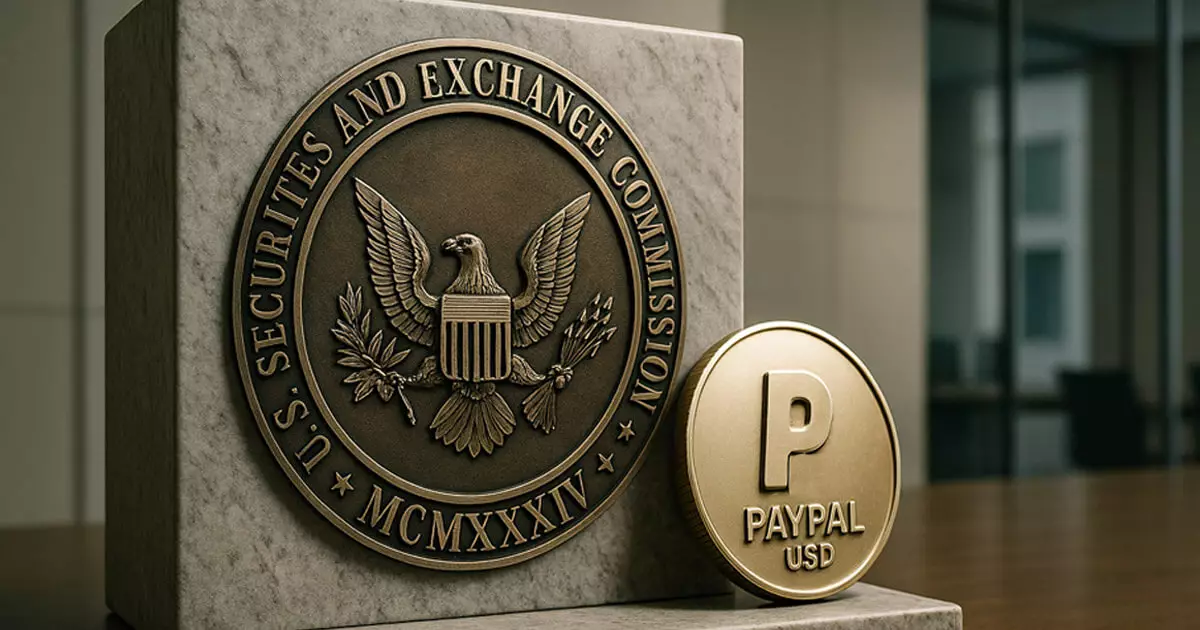The recent decision by the U.S. Securities and Exchange Commission (SEC) to close its inquiry into PayPal’s dollar-backed stablecoin, PYUSD, is not just a victory for the fintech giant; it’s a sign of shifting tides in the regulatory landscape surrounding cryptocurrencies. The previous uncertainty surrounding PYUSD’s classification as an unregistered security raised questions about the future of stablecoins in the U.S. market. Yet, with the conclusion of the inquiry, PayPal stands at a crossroads where innovation can thrive uninhibited by heavy-handed governmental oversight.
A deeper look at this situation reveals how the SEC’s choice to not pursue enforcement action symbolizes a cautious yet enlightening approach towards certain stablecoin frameworks. By opting to end its investigation without citing specific violations, the SEC may be acknowledging that its previous heavy-handed tactics under former Chairman Gary Gensler might not align with practical realities of the digital financial landscape. This is particularly encouraging for companies looking to innovate within the boundaries of regulatory guidelines, spurring growth rather than stifling it.
Legislative Momentum and the GENIUS Act
Buried within this unfolding narrative is the potential for enhanced legislative support for structured frameworks like the GENIUS Act, a bipartisan Senate proposal aimed at developing a clearer regulatory path for payment stablecoins. This proposed legislation reflects a significant shift towards formalizing the licensing of stablecoin issuers, lending an air of legitimacy and stability to a market riddled with ambiguity. Introducing requirements such as 1:1 reserve backing and monthly disclosures is a step in the right direction—an effort to secure consumer trust without resorting to the justifiable fears of overregulation.
These regulatory advancements could push PayPal to experiment more boldly with PYUSD, spurring broad adoption among small businesses that require reliable payment solutions. This isn’t just about creating an alternative to credit cards; it’s about ushering in a new era where traditional financial barriers dissolve. The vision of providing over 20 million small businesses with access to stablecoin transactions offers a tantalizing glimpse into a cashless future.
The Market Dynamics of PYUSD
Current market statistics indicate that PYUSD, with a circulating supply of roughly $879 million, still grapples for attention against giants such as Tether (USDT) and USD Coin (USDC). However, PayPal’s strategic integration of PYUSD into its ecosystem, including platforms like Venmo, positions it uniquely within a competitive arena. Clearing trading fees for PYUSD on exchanges like Coinbase is another clever maneuver that could improve liquidity and cultivate a user-friendly environment for transactions.
PayPal’s journey with PYUSD isn’t merely about reclaiming a market share; it’s a larger commentary on its ambition to reshape financial transactions. The focus on building infrastructure that facilitates stablecoins promises to disrupt traditional modalities of payment processing, creating a landscape where transactions can be executed with increased efficiency and reduced fees. However, the shadow of uncertainty remains, particularly regarding the custodial and legal ambiguities that surround digital asset handling.
Cautious Optimism Amid Regulatory Shadows
Nevertheless, even as the SEC pulls back from its aggressive enforcement stance on PYUSD, significant questions linger about the broader implications for digital assets. The complexities in ongoing investigations, including matters disassociated from PYUSD, demonstrate that PayPal is not entirely out of the woods. The Consumer Financial Protection Bureau’s ongoing scrutiny over PayPal Credit highlights persistent regulatory vigilance, illuminating the intricate relationship between innovation and compliance in the financial ecosystem.
At the same time, the SEC has stated that certain categories of stablecoins, classified as “Covered Stablecoins,” do not fall under federal securities laws. This clarification adds yet another piece to the puzzle but also represents the careful balancing act regulators must now perform. As Congress takes up the mantle to define clearer guidelines for stablecoins, the groundwork for pragmatism in the regulatory framework is being laid.
In evaluating this complex scenario, it becomes clear that PayPal’s victory with PYUSD is more than just an isolated incident. It marks an evolution in the conversation about stablecoins and financial innovation, one that balances the need for oversight while fostering an environment ripe for change. The future of digital assets is likely dependent on this delicate dance between regulation and innovation—one that is just beginning to unfold.


Leave a Reply